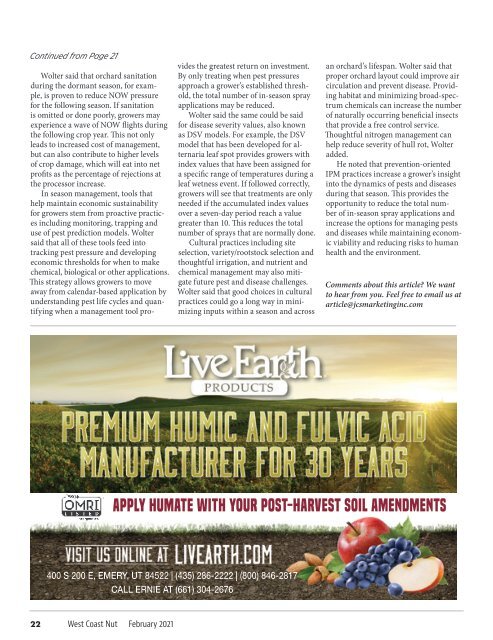You also want an ePaper? Increase the reach of your titles
YUMPU automatically turns print PDFs into web optimized ePapers that Google loves.
Continued from Page 21<br />
Wolter said that orchard sanitation<br />
during the dormant season, for example,<br />
is proven to reduce NOW pressure<br />
for the following season. If sanitation<br />
is omitted or done poorly, growers may<br />
experience a wave of NOW flights during<br />
the following crop year. This not only<br />
leads to increased cost of management,<br />
but can also contribute to higher levels<br />
of crop damage, which will eat into net<br />
profits as the percentage of rejections at<br />
the processor increase.<br />
In season management, tools that<br />
help maintain economic sustainability<br />
for growers stem from proactive practices<br />
including monitoring, trapping and<br />
use of pest prediction models. Wolter<br />
said that all of these tools feed into<br />
tracking pest pressure and developing<br />
economic thresholds for when to make<br />
chemical, biological or other applications.<br />
This strategy allows growers to move<br />
away from calendar-based application by<br />
understanding pest life cycles and quantifying<br />
when a management tool provides<br />
the greatest return on investment.<br />
By only treating when pest pressures<br />
approach a grower’s established threshold,<br />
the total number of in-season spray<br />
applications may be reduced.<br />
Wolter said the same could be said<br />
for disease severity values, also known<br />
as DSV models. For example, the DSV<br />
model that has been developed for alternaria<br />
leaf spot provides growers with<br />
index values that have been assigned for<br />
a specific range of temperatures during a<br />
leaf wetness event. If followed correctly,<br />
growers will see that treatments are only<br />
needed if the accumulated index values<br />
over a seven-day period reach a value<br />
greater than 10. This reduces the total<br />
number of sprays that are normally done.<br />
Cultural practices including site<br />
selection, variety/rootstock selection and<br />
thoughtful irrigation, and nutrient and<br />
chemical management may also mitigate<br />
future pest and disease challenges.<br />
Wolter said that good choices in cultural<br />
practices could go a long way in minimizing<br />
inputs within a season and across<br />
an orchard’s lifespan. Wolter said that<br />
proper orchard layout could improve air<br />
circulation and prevent disease. Providing<br />
habitat and minimizing broad-spectrum<br />
chemicals can increase the number<br />
of naturally occurring beneficial insects<br />
that provide a free control service.<br />
Thoughtful nitrogen management can<br />
help reduce severity of hull rot, Wolter<br />
added.<br />
He noted that prevention-oriented<br />
IPM practices increase a grower’s insight<br />
into the dynamics of pests and diseases<br />
during that season. This provides the<br />
opportunity to reduce the total number<br />
of in-season spray applications and<br />
increase the options for managing pests<br />
and diseases while maintaining economic<br />
viability and reducing risks to human<br />
health and the environment.<br />
Comments about this article? We want<br />
to hear from you. Feel free to email us at<br />
article@jcsmarketinginc.com<br />
APPLY HUMATE WITH YOUR POST-HARVEST SOIL AMENDMENTS<br />
400 S 200 E, EMERY, UT 84522 | (435) 286-2222 | (800) 846-2817<br />
CALL ERNIE AT (661) 304-2676<br />
22 West Coast Nut <strong>Feb</strong>ruary <strong>2021</strong>


















